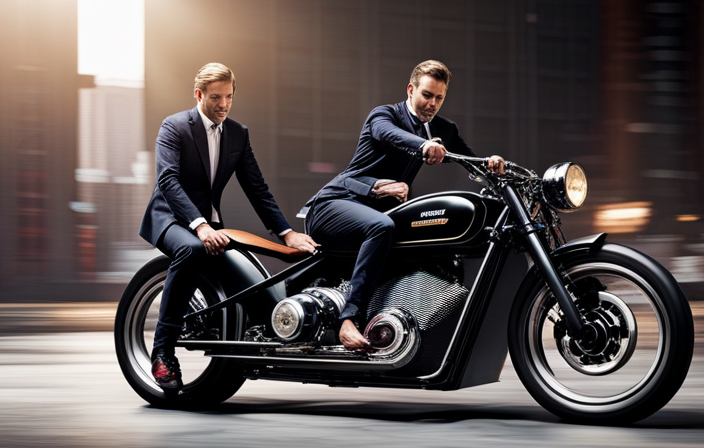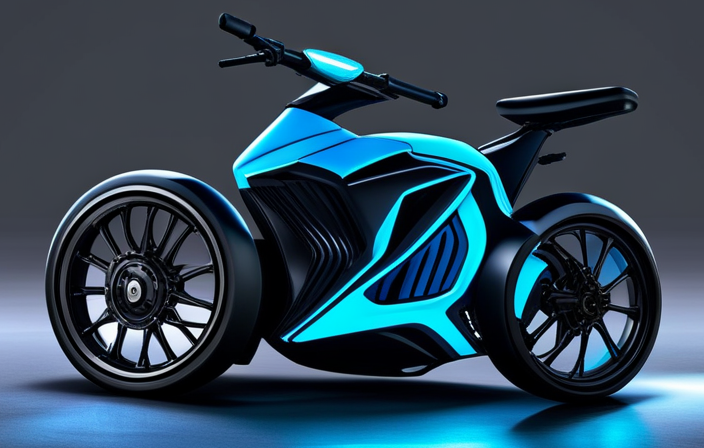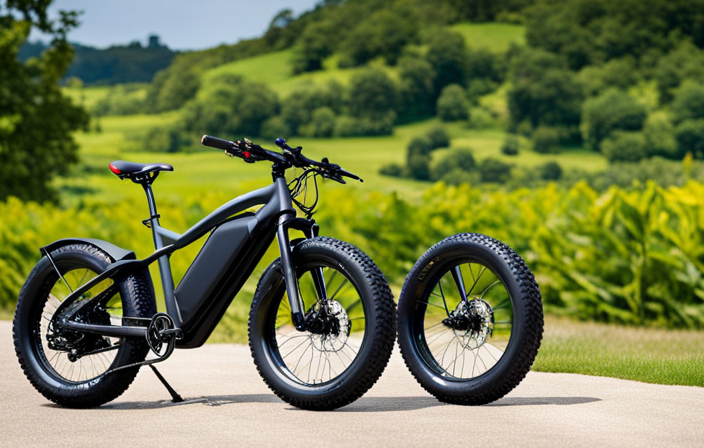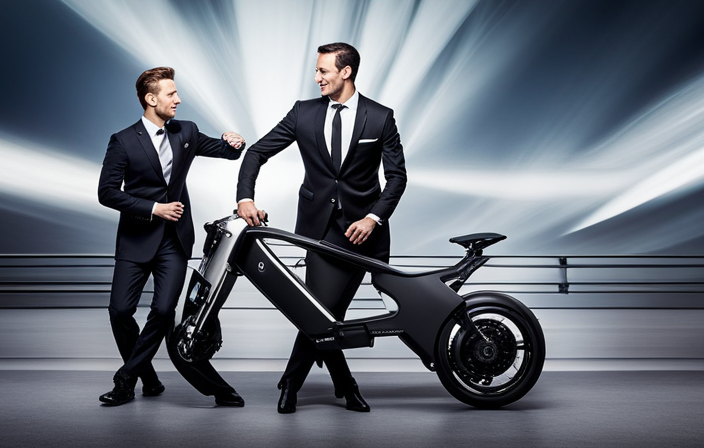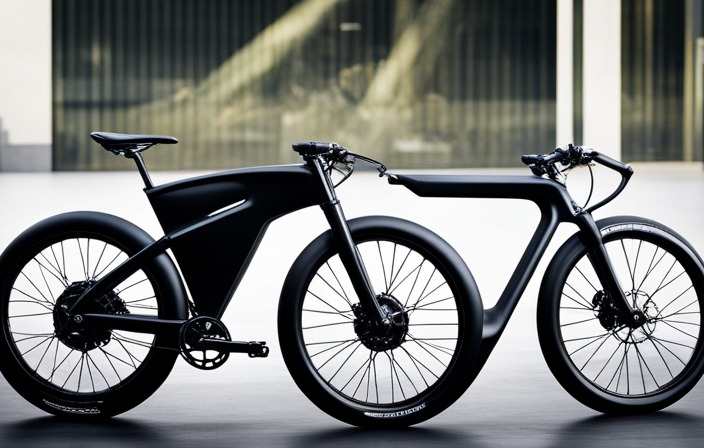Have you ever pondered when the first electric motorcycle was created? Have you ever thought about the beginnings of this environmentally friendly mode of transportation?
In this article, I will delve into the early experiments with electric propulsion, the development of the first electric motorbike prototype, and the advancements in battery technology that paved the way for its rise in the early 20th century.
We will also explore the challenges faced by electric motorbikes, their growing popularity in racing, and the future of this industry.
So, let’s dive into the fascinating history of electric motorbikes!
Key Takeaways
- Electric propulsion experiments date back to the 19th century, with Thomas Davenport building a small electric motor in 1835.
- The first e-bike prototype was developed in the late 1800s, laying the foundation for future improvements in battery technology, motor efficiency, and overall design.
- Lithium-ion batteries revolutionized the e-bike industry, offering higher energy density, longer lifespan, and faster charging times, with further advancements expected.
- Electric motorcycles gained popularity as a new form of transportation, with the first practical electric motorcycle built in 1884 by Thomas Parker. Racing events showcased the performance and capabilities of e-bikes.
Early experiments with electric propulsion
You might be surprised to learn that early inventors were already experimenting with electric propulsion for bikes as far back as the 19th century. These early experiments were fueled by the desire to find alternative forms of transportation that were cleaner and more efficient than traditional methods. Technological advancements in electricity and battery technology played a crucial role in making these experiments possible.
One of the earliest pioneers in electric propulsion for bikes was Thomas Davenport, an American inventor. In 1835, he built a small electric motor that could power a model electric car. While not specifically designed for bikes, this invention laid the groundwork for future developments in electric transportation.
Throughout the 19th century, inventors continued to refine electric propulsion systems for various modes of transportation, including bicycles. However, these early experiments faced significant limitations due to the technological constraints of the time. Batteries were heavy and had limited capacity, making it difficult to achieve practical and efficient electric bikes.
Nevertheless, these early experiments paved the way for further advancements in electric motorbike technology. The first electric motorbike prototype was eventually created, marking a significant milestone in the history of electric transportation. Transitioning from the early experiments to the first electric motorbike prototype required continuous innovation and overcoming numerous challenges.
The first electric motorbike prototype
The first prototype of an e-bike was developed in the late 1800s. These early prototypes were a result of the growing interest in electric propulsion during that time. Inventors were experimenting with different designs and technologies to create a motorbike that could be powered by electricity. These early models were often bulky and had limited range, but they laid the foundation for future advancements in e-bike technology.
Over the years, there have been significant technological advancements in the field of e-bikes. The early prototypes paved the way for improvements in battery technology, motor efficiency, and overall design. As battery technology advanced, e-bikes became more practical and efficient. Lithium-ion batteries, for example, provided higher energy density and longer range compared to earlier battery types.
Advances in motor efficiency also played a crucial role in the development of e-bikes. Modern electric motors are smaller, lighter, and more powerful than their predecessors. This improvement in motor technology has allowed for faster acceleration and higher top speeds.
In conclusion, the first e-bike prototypes from the late 1800s laid the foundation for the technological advancements we see in modern e-bikes today. From improved battery technology to more efficient motors, these developments have made e-bikes a viable alternative to traditional bicycles.
In the next section, we will explore the advances in battery technology that have further revolutionized the e-bike industry.
Advances in battery technology
Advances in battery technology have greatly improved the performance and range of e-bikes. Over the years, there have been significant developments in battery technology that have revolutionized the electric bike industry.
One of the key advancements is the introduction of lithium-ion batteries. These batteries offer higher energy density, longer lifespan, and faster charging times compared to their predecessors.
The use of lithium-ion batteries in e-bikes has allowed for increased power and range. With improved energy storage capabilities, riders can now enjoy longer rides without worrying about running out of battery power. Additionally, lithium-ion batteries are lighter and more compact, making them ideal for e-bike applications. This has resulted in sleeker and more streamlined e-bike designs.
Furthermore, advancements in battery management systems (BMS) have improved the overall efficiency and performance of e-bikes. BMS technology allows for better monitoring and control of battery usage, ensuring optimal performance and extending battery life. This has led to improved reliability and increased customer satisfaction.
As battery technology continues to advance, we can expect even more exciting developments in the e-bike industry. The rise of electric motorcycles in the early 20th century marked a significant milestone in the evolution of electric transportation.
The rise of electric motorcycles in the early 20th century
During the early 20th century, electric motorcycles gained popularity as a new form of transportation. A number of early electric motorcycle pioneers played a crucial role in the development and promotion of these vehicles. One notable pioneer was Thomas Parker, an English inventor who built the first practical electric motorcycle in 1884. His invention utilized a rechargeable battery and a motor, and it quickly gained attention for its quiet operation and lack of emissions.
However, the early electric motorcycles faced several challenges. One of the main obstacles was the limited range offered by the batteries of that time. Early batteries had relatively low capacity and could only provide a short distance of travel before needing to be recharged. Additionally, the charging infrastructure was virtually nonexistent, making it difficult for riders to find suitable places to recharge their motorcycles.
Furthermore, the early electric motorcycles struggled with limited power. The motors available at the time were not as efficient as those found in internal combustion engines, resulting in slower speeds and reduced performance.
Despite these challenges, the early pioneers continued to refine and improve electric motorcycles, laying the foundation for the future advancements in the industry. Transitioning into the subsequent section about challenges and setbacks for electric motorbikes, it becomes clear that these early obstacles were just the beginning of a long journey toward making electric motorcycles a viable mode of transportation.
Challenges and setbacks for electric motorbikes
One of the main obstacles faced by early electric motorcycles was the limited range offered by the batteries of that time. This, along with other challenges in manufacturing and adoption barriers, hindered the widespread acceptance of electric motorcycles.
-
Battery technology: The batteries available in the early days were heavy, bulky, and had limited capacity. This resulted in shorter riding distances and frequent recharging, making electric motorcycles impractical for long journeys.
-
Charging infrastructure: The lack of charging stations was a significant barrier to adoption. Without a widespread network of charging points, riders were limited in their ability to refuel their electric motorcycles, further restricting their range and usability.
-
Cost: Electric motorcycles were initially more expensive than their internal combustion engine counterparts. The high cost of batteries and limited economies of scale in manufacturing contributed to the higher price tag, making it difficult for electric motorcycles to compete in the market.
-
Perception and awareness: Many people were skeptical about the performance and reliability of electric motorcycles, leading to a lack of demand. Limited marketing efforts and a general lack of awareness about the benefits of electric motorcycles also contributed to the slow adoption.
Despite these challenges, the resurgence of electric motorcycles in the 21st century has seen significant improvements in battery technology, the establishment of charging networks, cost reductions, and increased awareness among consumers. These advancements have paved the way for a new era of electric motorcycles, offering improved range, performance, and affordability.
The resurgence of electric motorcycles in the 21st century
If you’re considering buying a new motorcycle, you’ll be pleased to know that electric models have made a remarkable comeback in the 21st century. Electric motorcycles have gained significant popularity in recent years and have become a prominent feature in popular culture. They are now seen as a symbol of modernity and environmental consciousness. With advancements in technology, electric motorcycles have become more accessible and practical for everyday use.
This resurgence of electric motorcycles has had a profound impact on traditional motorcycle manufacturers. Companies like Harley-Davidson and Yamaha have recognized the growing demand for electric models and have started incorporating them into their product lineups. This shift not only reflects the changing preferences of consumers but also highlights the need for traditional manufacturers to adapt to the evolving market.
The popularity of electric motorcycles can be attributed to various factors. Firstly, the rising concern for the environment has led many individuals to opt for more sustainable modes of transportation. Electric motorcycles offer a cleaner and greener alternative to traditional gasoline-powered bikes, as they produce zero emissions and have lower carbon footprints. Additionally, the advancements in battery technology have resulted in improved performance and longer ranges, making electric motorcycles a viable option for riders.
As the industry continues to evolve, the impact of environmental concerns on the motorcycle industry becomes increasingly significant. The growing awareness of climate change and the need to reduce carbon emissions have prompted governments and individuals to actively seek out environmentally friendly transportation options. This shift in consumer preferences has pushed motorcycle manufacturers to invest more in electric technology and develop innovative solutions to meet the demands of the market.
The impact of environmental concerns on the industry
The impact of environmental concerns on the industry can be seen through the growing demand for more sustainable transportation options. As people become more aware of the negative effects of traditional vehicles on the environment, they are seeking alternatives that are cleaner and more eco-friendly.
One of the ways this is being addressed in the electric motorcycle industry is through battery recycling. Batteries used in electric motorcycles contain valuable materials that can be reused, reducing the need for new resources and minimizing waste. This not only helps to protect the environment but also has a positive impact on job creation. The process of battery recycling requires skilled workers to collect, sort, and process the batteries, creating new employment opportunities.
Additionally, the growing demand for electric motorcycles and the need for battery recycling infrastructure has led to the development of new businesses and industries, further contributing to job creation. This shift towards sustainability not only benefits the environment but also has a significant impact on the economy, promoting innovation and creating employment opportunities.
Furthermore, as the market for electric motorcycles continues to grow, the development of electric motorbike charging infrastructure becomes crucial.
The development of electric motorbike charging infrastructure
To ensure convenience, you’ll need to consider the availability and accessibility of charging stations for your electric motorcycle. The evolution of charging stations has been crucial in supporting the growing number of electric vehicles on the road, including electric motorcycles.
In the early days, charging stations were limited in number and often difficult to find. However, as the demand for electric vehicles has increased, so has the development of charging infrastructure.
Today, charging stations can be found in various locations such as public parking lots, shopping centers, and even residential areas. This increased accessibility has made it easier for electric motorcycle owners to charge their vehicles while on the go. Additionally, advancements in charging technology have led to faster charging times, further improving the convenience of owning an electric motorcycle.
Furthermore, the impact of charging stations on the electric grid cannot be overlooked. As more electric motorcycles are being charged, the demand on the grid increases. This has necessitated upgrades and improvements to the grid infrastructure to accommodate the growing number of electric vehicles.
With the development of charging stations and improvements to the electric grid, electric motorcycle owners can enjoy the convenience of charging their vehicles easily and efficiently. This evolution of charging infrastructure sets the stage for the subsequent section on the evolution of electric motorbike design and performance.
The evolution of electric motorbike design and performance
As we discussed in the previous section, the development of electric motorbike charging infrastructure has been crucial in promoting the adoption of electric motorbikes. However, it is not just the charging infrastructure that has seen significant advancements.
The evolution of electric motorbike design and performance has also played a vital role in making these vehicles more appealing and practical.
One area where electric motorbikes have shown great potential is in off-road adventures. With their instant torque and quiet operation, electric motorbikes have become a popular choice for off-road enthusiasts. The ability to navigate rough terrains and explore remote areas without disturbing the natural habitat is a major advantage of electric motorbikes. Additionally, the absence of engine noise allows riders to enjoy the serene beauty of nature without any distractions.
Another significant development in electric motorbike design is the integration of smart technology. Manufacturers have started incorporating advanced sensors, connectivity features, and intelligent systems into their electric motorbikes. These technologies not only enhance the riding experience but also provide valuable information to the rider. For example, smart displays can show real-time battery status, range estimation, and even suggest nearby charging stations. Moreover, some electric motorbikes are equipped with GPS navigation systems specifically designed for off-road adventures, ensuring that riders stay on track even in remote areas.
As we can see, the potential of electric motorbikes for off-road adventures and the integration of smart technology in electric motorbike design have greatly improved the overall experience for riders. However, electric motorbikes are not limited to off-road use only.
In the next section, we will explore the role of electric motorbikes in urban transportation and how they are shaping the future of commuting.
The role of electric motorbikes in urban transportation
If you’re looking for an efficient and eco-friendly way to navigate through busy urban streets, electric motorbikes can be a great option. These vehicles have gained popularity in recent years due to their numerous advantages, especially in the context of urban planning and renewable energy integration. Electric motorbikes offer a sustainable and convenient mode of transportation that aligns with the goals of creating greener cities.
To paint a clearer picture, let’s take a closer look at the benefits of electric motorbikes in urban transportation:
| Advantages | Description |
|---|---|
| Zero Emissions | Electric motorbikes produce no tailpipe emissions, contributing to cleaner air in urban areas and reducing the carbon footprint of transportation. |
| Noise Reduction | Compared to traditional motorcycles, electric motorbikes operate quietly, minimizing noise pollution in densely populated areas. |
| Compact Design | With their smaller size and maneuverability, electric motorbikes can easily navigate through congested city streets, allowing for quicker and more efficient commuting. |
| Renewable Energy Integration | Electric motorbikes can be charged using electricity generated from renewable sources, such as solar or wind power, further reducing their environmental impact and promoting sustainability. |
Not only do electric motorbikes offer these advantages, but they also provide a range of benefits for commuters, as we will explore in the next section.
The benefits of electric motorbikes for commuters
Commuters can greatly benefit from the convenience and efficiency of electric motorbikes. The latest models are equipped with high-capacity batteries that can provide a range of up to 100 miles on a single charge. This means that commuters can easily travel to and from work without worrying about running out of power. Electric motorbikes also have lower operating costs compared to traditional gasoline-powered bikes. The cost of electricity is significantly lower than the cost of gasoline, making electric motorbikes a more economical choice in the long run. Not only do electric motorbikes save money on fuel, but they also require less maintenance. With fewer moving parts and no need for oil changes, electric motorbikes can save commuters both time and money.
In conclusion, electric motorbikes offer commuters the convenience of longer battery life and lower operating costs, making them a practical and efficient choice for daily transportation.
As electric motorbikes continue to gain popularity among commuters, they are also making waves in the world of racing.
The growing popularity of electric motorbike racing
The growing popularity of electric motorbike racing is evident in the increasing number of participants and spectators. Electric motorbike racing championships have become a thrilling and competitive sport that is rapidly gaining recognition worldwide. This emerging trend has had a significant impact on traditional motorcycle racing, sparking debates and discussions about the future of the sport.
To better understand the impact of electric motorbike racing, let’s take a closer look at the following table:
| Electric Motorbike Racing Championships | Traditional Motorcycle Racing |
|---|---|
| Growing number of participants | Declining participation |
| Increased spectator interest | Decreased fan engagement |
| Technological advancements | Limited innovation |
| Environmental sustainability | Higher carbon emissions |
The rise of electric motorbike racing has attracted a new generation of riders and fans, drawn to the sport’s futuristic appeal and commitment to eco-friendly practices. This shift has forced traditional motorcycle racing to re-evaluate its strategies to remain relevant in an evolving landscape.
As we explore the future of electric motorbikes and emerging technologies, it is clear that this trend is not just a passing fad. The advancements in electric motorbike technology, such as improved battery life and faster charging capabilities, are propelling the sport forward. These developments will undoubtedly shape the future of motorbike racing, paving the way for a more sustainable and thrilling racing experience.
Transitioning into the subsequent section about the future of electric motorbikes and emerging technologies, we can see that the growing popularity of electric motorbike racing is just the beginning of a groundbreaking era in the world of motorcycles.
The future of electric motorbikes and emerging technologies
Get ready to embrace a new era of innovative technology and advancements in the world of electric motorbikes. As emerging technologies continue to shape the future of transportation, electric motorbikes are poised to become a prominent mode of eco-friendly and efficient travel.
Here are some exciting future trends and emerging technologies that will revolutionize the electric motorbike industry:
-
Enhanced battery technology: The development of more powerful and long-lasting batteries will significantly improve the range and performance of electric motorbikes.
-
Wireless charging: Imagine effortlessly charging your electric motorbike by simply parking it on a designated pad. Wireless charging technology is on the horizon, making the charging process more convenient than ever.
-
Smart connectivity: Integration of smart technology will allow electric motorbike riders to connect their bikes to smartphones or other devices, enabling navigation, real-time diagnostics, and enhanced safety features.
-
Lightweight materials: Advances in material science will result in lighter and stronger electric motorbikes, enhancing performance and increasing efficiency.
These emerging technologies are just a glimpse of what the future holds for electric motorbikes. As the industry grows, government incentives and regulations for electric motorbikes will play a crucial role in their adoption and widespread use.
Government incentives and regulations for electric motorbikes
In the previous section, we explored the future of electric motorbikes and the emerging technologies that are shaping this industry. Now, let’s turn our attention to the role of government incentives and regulations in promoting the adoption of electric motorbikes.
Governments around the world have recognized the environmental and energy-saving benefits of electric vehicles, including electric motorbikes. As a result, many countries have implemented various incentives to encourage consumers to switch to electric vehicles. These incentives often include financial subsidies or tax credits for purchasing electric motorbikes, as well as exemptions from certain taxes or tolls. By reducing the initial cost of electric motorbikes, these incentives aim to make them more accessible and appealing to consumers.
Furthermore, governments have also introduced regulations to facilitate the use of electric motorbikes on public roads. These regulations typically cover areas such as licensing, safety standards, and charging infrastructure. For example, some countries require electric motorbike riders to hold a special license or undergo specific training. Additionally, regulations may mandate the installation of charging stations in public areas to ensure convenient access to charging facilities.
With government incentives and regulations in place, the adoption of electric motorbikes is expected to increase significantly in the coming years. As more countries prioritize sustainability and clean transportation, the global market for electric motorbikes is poised for substantial growth. In the next section, we will explore this market in greater detail and discuss the key players in the industry.
The global market for electric motorbikes and key players in the industry
As the market for electric motorbikes continues to grow, key players in the industry are emerging to meet the demand. The global market for electric motorbikes is experiencing significant growth due to several factors. One of the main drivers of this growth is the increasing awareness and concern about environmental issues. With the rising levels of pollution and the need to reduce carbon emissions, many consumers are turning to electric motorbikes as a greener and more sustainable transportation option.
In addition to environmental concerns, technological advancements have also played a crucial role in fueling the growth of the electric motorbike market. The development of more efficient batteries and motors has greatly improved the performance and range of electric motorbikes, making them a viable alternative to traditional gasoline-powered bikes. Furthermore, advancements in charging infrastructure have made it easier for consumers to charge their electric motorbikes, alleviating concerns about range anxiety.
Several key players have emerged in the electric motorbike industry to capitalize on the growing market trends and technological advancements. Companies like Zero Motorcycles, Energica, and Harley-Davidson are leading the way in producing high-performance electric motorbikes that cater to the needs of consumers. These companies are continuously investing in research and development to further improve the technology and offer innovative features to attract more customers.
Frequently Asked Questions
How have government incentives and regulations impacted the electric motorbike industry?
Government incentives and regulations play a crucial role in the growth of the electric motorbike industry. By providing financial incentives and creating supportive policies, governments have encouraged the adoption of electric motorbikes and helped drive innovation in the industry.
What are some emerging technologies that could shape the future of electric motorbikes?
Emerging technologies like advanced battery technology and improved charging infrastructure hold tremendous promise for the future of electric motorbikes. These innovations will enhance range, reduce charging times, and make electric bikes even more convenient and practical for riders.
Who are the key players in the global market for electric motorbikes?
In the global market for electric motorbikes, key players include companies like Zero Motorcycles, Energica, and Harley-Davidson. These companies are leading the way in developing innovative electric motorbike technologies and are driving the growth of the market.
How has the evolution of electric motorbike design and performance influenced their popularity?
The evolution of electric motorbike design and performance has significantly influenced their popularity. Electric motorbike design innovations and performance advancements have made them more appealing and efficient, leading to increased adoption and interest among consumers.
What are the benefits of electric motorbikes for commuters compared to traditional gasoline-powered motorcycles?
Electric motorbikes offer numerous benefits for commuters compared to traditional gasoline-powered motorcycles. They are environmentally friendly, producing zero emissions, and can help reduce air pollution. Additionally, electric motorbikes are cost-effective, saving money on fuel and maintenance expenses.
Conclusion
As I conclude my research on the history and future of electric motorbikes, I am in awe of the progress made in this industry. From the early experiments and prototypes to the advancements in battery technology, electric motorcycles have come a long way.
Despite challenges and setbacks, the growing popularity of electric motorbike racing shows the immense potential of this technology. With government incentives and regulations in place, the global market for electric motorbikes is expanding rapidly.
It is clear that electric motorbikes are not just a trend, but the future of transportation.
